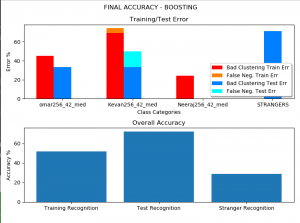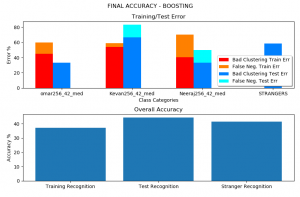- What did you personally accomplish this week on the project? Give files or photos that demonstrate your progress. Prove to the reader that you put sufficient effort into the project over the course of the week (12+ hours).
I implemented cosine distance as a distance metric for understanding whether someone was a stranger. This was done by finding the cosine distance of all training points and selecting a percentile of those points for which I consider any new image with a cosine distance to its nearest centroid larger than that the cosine distance of that percentile to be a stranger. I ran tests to compare how effective this was at detecting strangers versus Euclidean distance. I also compared how detrimental they were to false negatives: wherein a sample is falsely not considered one of the students (i.e. a stranger) because its cosine distance is too high, however, the nearest centroid (i.e. our prediction) is actually the correct individual. These false negatives eat away at our accuracy because of poor stranger detection.

Above are the results of using E2. Stranger accuracy is about 30%. Any more stringent stranger detection causes too many false negatives.

Above are the results of using cosine distance. Stranger accuracy is about 40%. However, training recognition suffered from false negatives (see orange bars in the above graph).
I also reviewed the PCA and LDA code with Professor Savvides. Also, I ordered a laptop webcam, mount, and cable.
- Is your progress on schedule or behind? If you are behind, what actions will be taken to catch up to the project schedule?
-
- On schedule.
-
- What deliverables do you hope to complete in the next week?
- Improve stranger detection by better leveraging cosine distance.
